Poole and District Electric Tramways
Summary
The Poole and District Electric Traction Company was a subsidiary of the much larger British Electric Traction Company Ltd (BETCo), a concern which over the course of its history either owned, part-owned or leased around fifty tramway concerns across the British Isles. The photographs below show Poole and District Electric Tramways staff wearing the familiar and largely regulation BETCo uniform. Although the jacket styles varied somewhat between BETCo systems, as well as across the years, the cap badges, collar designations and buttons invariably followed a standard pattern.
Although the P&DET only existed as an independent concern for a mere four years (1901 to 1905) before being sold to Bournemouth and Poole Corporations (the track within their respective boundaries, and a share of the assets), a reasonable number of photographs showing tramway staff have in fact survived. Unfortunately, the vast majority of these photos are undated, which makes the task of establishing a precise chronology for the uniforms difficult, especially as there appear to have been three distinct styles in this relatively short period. What follows is therefore conjectural, and may need to be changed as and when new photographs are discovered.
The first photograph below indicates that tramcar crews were initially issued with single-breasted tunics with five buttons and stand-up collars; the latter seem to have carried script lettering insignia, almost certainly embroidered; this would have been either system initials ('P&DET') or company initials ('P&DETC'). The jackets were complemented by kepi-style caps that bore embroidered system initials – 'P & D E T' – in block capitals. It is perhaps worth noting that the use of embroidered insignia seems to have been a general policy of the BETCo around the turn of the century, before it switched to brass insignia; an early date is also supported by the tramcar, which is in pristine condition. Other surviving photographs of the earliest years of operation indicate that tramcar staff were allowed to wear straw boaters in summer.
At some point, probably within the first year or two of opening (i.e., 1902/3), the uniform was changed to a design used on many other BETCo-operated systems at this time. The jackets were now double breasted with four pairs of closely spaced buttons (presumably brass; see link), and an extra pair buttoning between the lapels and the collars; the latter bore embroidered, block-capital system initials — 'P & D E T' — on both sides. The earlier kepi-style caps were superseded by soft-topped, peaked caps; these bore metal insignia, almost certainly brass: an employee number at the bottom, with the standard British Electric Traction Company 'Magnet & Wheel' badge above.
This style of uniform jacket does not, however, appear to have lasted long, as photographs taken in the system's later years show tramcar crews wearing double-breasted, lancer-style tunics with five pairs of buttons (narrowing from top to bottom) and stand-up collars; the latter now carried metal system-initials badges in individual brass letters. The P&DET was in a small minority amongst BETCo tramway systems in applying metal system initials to both collars, the majority using an employee number on one side. Probably at the same time, the caps were changed to a tensioned-crown type giving a generally smarter appearance.
A single photograph has survived of an inspector, which though of poor quality, does show that inspectors wore typical tramway inspector garb, i.e., single-breasted jackets with hidden buttons (or an hook and eye affair), two slit breast pockets (probably) and stand-up collars; the latter bore 'Inspector' in embroidered script lettering on both sides. The jackets (including the slit breast pockets) were edged in a finer material than the main jacket, the sleeves probably also being embellished with a chevron of the same material. Headgear took the form of a soft-topped peaked cap, though this was in all likelihood relatively quickly superseded by a similar cap but with a tensioned-crown; both types carried the standard BETCo 'Magnet & Wheel' cap badge, below which was the grade – 'Inspector' – in embroidered script lettering on a hat band.
For a history of the system, see: 'Trams and Buses of Poole' by C G Roberts and B L Jackson; The Oakwood Press (2001).
Images
Motormen and conductors
A conductor and a motorman pose with Tramcar No 2 at County Gates — photo undated, but given the pristine condition of the tram, probably taken in the first year of operation (1901). Photo courtesy of the Tramways and Light Railway Society, with thanks to David Voice.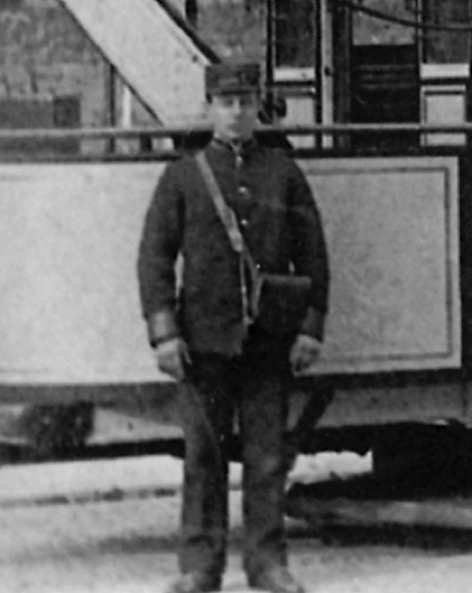
An enlargement of the above photograph showing the conductor. His jacket collars and cap appear to bear script-lettering insignia, probably embroidered; additionally, and surprisingly, there is no evidence of the standard BETCo 'Magnet & Wheel' device cap badge.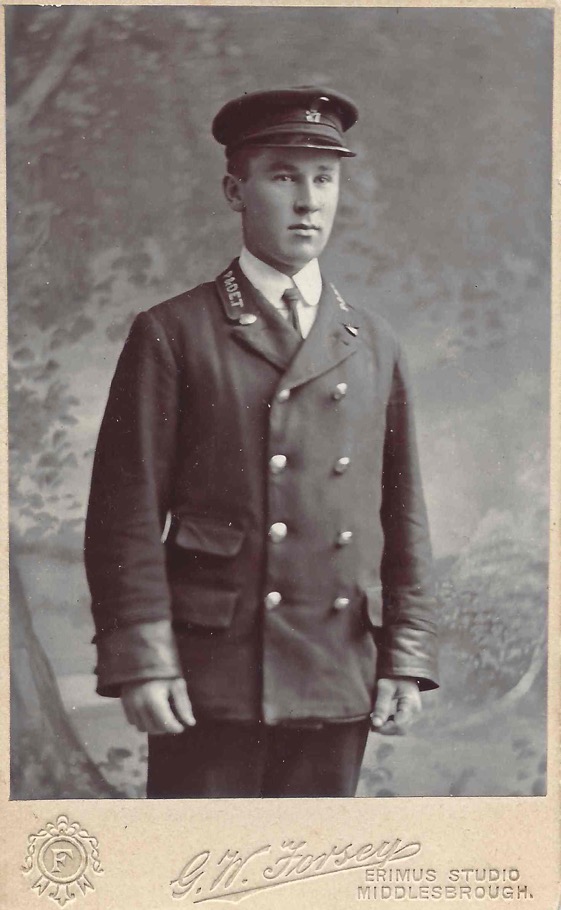
Poole and District Electric Tramways Conductor James Doble. Although the photograph is undated, it was probably taken in late 1901 or 1902 as the design of uniform jacket and cap differ from the earliest photographs. The double-breasted jacket bears embroidered block-capital system initials — 'P & D E T' — on both sides. The soft-topped peaked cap bears an employee number ('27'), above which is a standard BETCo 'Magnet & Wheel' badge. James Doble was born in 1882 in Crewkerne, Somerset. He probably didn't work on the tramway for very long, as he eventually moved to stay with his sister in Dorset, before emigrating to Canada, arriving on the 7th July 1905. He worked on the trams in Toronto (presumably the Metropolitan Street Railway), but tragically died in 1912 when he was crushed by a wall. Quite why the mount is from a studio at the opposite end of the country (Middlesbrough) is unclear, as he certainly would not have travelled there with his uniform. My thanks to James' granddaughter, Karen Johnson.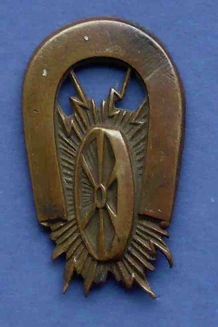
Standard British Electric Traction Company ‘Magnet & Wheel’ cap badge — brass. Author's Collection.
A staff photograph at Parkstone depot – photo undated, but probably taken around 1902/3. Photo courtesy of the National Tramway Museum. 
An enlargement of the above photograph showing the second style of uniform jacket, which was double-breasted with lapels. The man in the centre is wearing a soft-topped peaked cap bearing the BETCo 'Magnet & Wheel' badge above an employee number, the two men either side are still wearing the older kepi-style caps with embroidered system initials 'P & D E T'.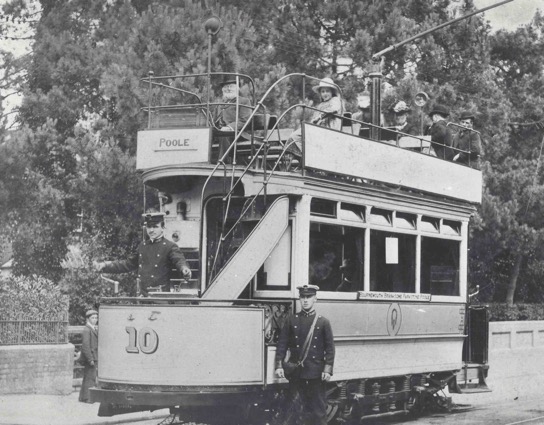
The crew of Tramcar No 10 stand patiently for the cameraman at County Gates — photo undated, but given the pristine paintwork, probably taken in 1902. Both men are wearing lancer-style tunics rather than the earlier single-breasted or double-breasted designs of jacket. Photo courtesy of Karen Johnson.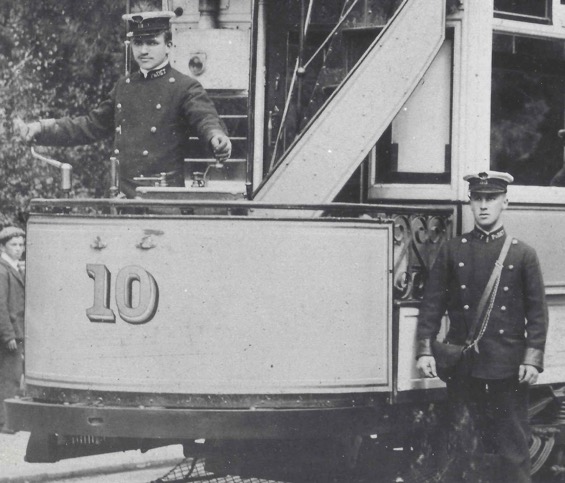
An enlargement of the above photograph showing the motorman and the conductor (James Doble; see studio portrait above). The jackets collars now bear metal system initials 'P & D E T' rather than the earlier embroidered insignia. The caps now have tensioned crown, giving a smarter appearance than their predecessors. Although the caps bear employee numbers, above which would have been the standard BETCo 'Magnet & Wheel' badge, this has been scratched off (presumably on the negative or glass plate); quite why this was done is unclear, as the tramcar itself still has the device on its waist panel. 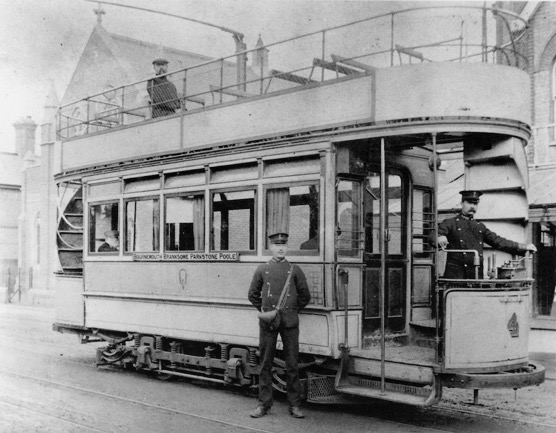
A conductor and a motorman pose with Tramcar No 4 in Ashley Road, Parkstone — photo undated, but given the slightly shabby paintwork, it was probably taken in the latter years of company operation, i.e., 1904/1905. Photo courtesy of the Tramways and Light Railway Society, with thanks to David Voice.
An enlargement of the above photograph showing the conductor and the motorman; both men are wearing the standard BETCo 'Magnet & Wheel' and employee number badges on their caps, and system initials — 'P & D E T' — on their collars.
Senior staff
An enlargement of the 1902/3 staff photograph above showing the inspector. He is wearing the standard attire that the BETCo favoured for this grade.